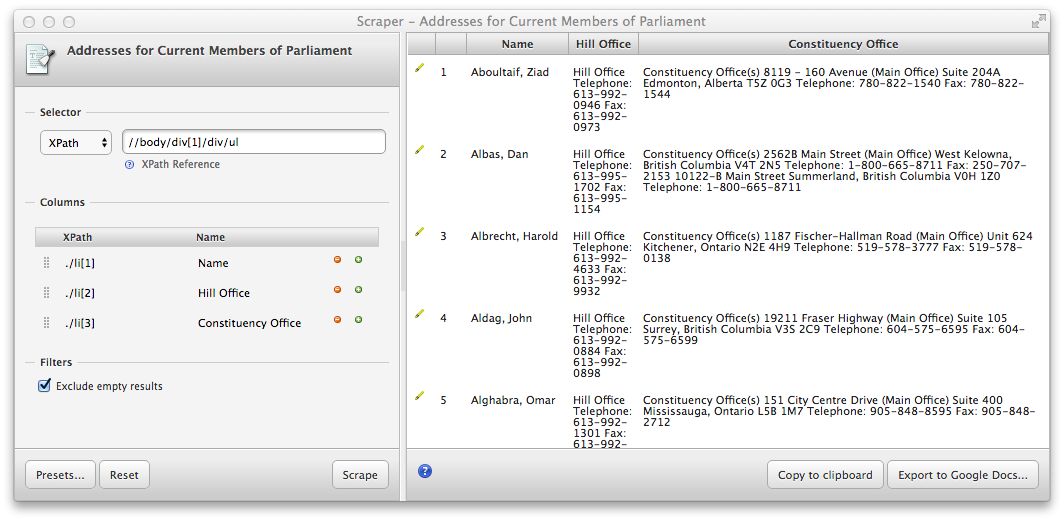

Related question 3 text (Text) – (//g-accordion-expander//h3).Related question 2 text (Text) – (//g-accordion-expander//h3).Related question 1 text (Text) – (//g-accordion-expander//h3).Featured snippet URL (Inner HTML) – Featured snippet image source (Text) – questions XPath syntax.Featured snippet page title (Text) – Featured snippet text paragraph (Text) – Featured snippet bullet point text (Text) – Featured snippet numbered list (Text) – Featured snippet table (Text) – //table//tr.If you’re already an XPath and scraping expert and are just here for the syntax and data type to setup your extraction (perhaps you saw me eloquently explain the process at SEOCamp Paris or Pubcon Las Vegas this year!), here you go (spoiler alert for everyone else!) – Featured snippet XPath syntax This guide focuses on featured snippets and related questions specifically, but the principles remain the same for scraping other features too.

WEBSCRAPER XPATH QUERY HOW TO
I’ll demonstrate how to scrape data from the SERPs using the Screaming Frog SEO Spider using XPath, and show just how easy it is to grab a load of relevant and useful data very quickly.

This guide runs through the process of gathering search feature data from the SERPs, to help scale your analysis and optimisation efforts. With organic CTR seemingly on the decline, optimising for Google search features is more important than ever, to ensure content is as visible as it possibly can be to search users. Reverse engineering why certain features appear for particular query types and analysing the data or text included in said features can help inform us in making optimisation decisions. Understanding these features can be powerful for SEO. Data suggests that some features such as related questions may feature on nearly 90% of SERPs today – a huge increase over the last few years. Google search features are a regular occurrence on most SERPs nowadays, some of most common features being featured snippets (aka ‘position zero’), knowledge panels and related questions (aka ‘people also ask’).
WEBSCRAPER XPATH QUERY MANUAL
This example demonstrates how to use Set manual Xpath to take hidden ratings from a web page.Google’s search engine results pages (SERPs) have changed a great deal over the last 10 years, with more and more data and information being pulled directly into the results pages themselves. The following examples demonstrate possible ways to select elements using manual XPath.Įxample: Scraping Hidden Latitude/Longitude Cancel: Closes screen and saves your XPath Selector.Enter attribute: enter attribute node of element node (this field is optional).Enter Manual path / XPath: enter XPath of the element you want to select.The Use Manual XPath dialogue box appears.Go to Selector → Create a new column by clicking on the button Add New Column, then click the Column Options dropdown arrow and select Use XPath selector.If you are not familiar with XPath, then you will first want to start with an ultimate guide to XPath. Select data from a drop-down list or undisplayed tab.you need data, such as latitude and longitude, from a map where it isn't readily available.Here are a few cases where it might be necessary (or at least a lot more elegant) to use manual XPath. In some cases, elements you want to extract from the page is hidden or not selectable in the selector,Īt that time you can use an alternative way: M anual XPaths or CSS selector to select those elements on the page. You can simply click on each element on the page to select and extract. ProWebScraper has its own Selector to select the elements that you would like to scrape from the website.


 0 kommentar(er)
0 kommentar(er)
